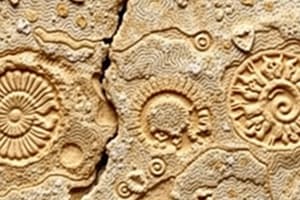Podcast
Questions and Answers
Which process usually happens first in the formation of fossils?
Which process usually happens first in the formation of fossils?
- The skeleton or body turns into rock and becomes a fossil
- The compounds in the bones of the animal are replaced by molecules of silica or carbonate
- The carcass decomposes or is broken down by scavengers
- The buried skeleton or full body is exposed to high pressures and temperatures (correct)
What are the chances of an organism becoming a fossil?
What are the chances of an organism becoming a fossil?
- Depends on the type of organism
- Very small (correct)
- Moderate
- High
What happens to the buried skeleton or full body over time?
What happens to the buried skeleton or full body over time?
- It is exposed to high pressures and temperatures
- The compounds in the bones are replaced by molecules of silica or carbonate
- It turns into rock and becomes a fossil
- It decomposes or is broken down by scavengers (correct)
How are the compounds in the bones of the animal replaced during fossilization?
How are the compounds in the bones of the animal replaced during fossilization?
How might a fossil be discovered by a palaeontologist?
How might a fossil be discovered by a palaeontologist?
Which of the following is NOT a feature of the Grade 10 Teacher's Guide?
Which of the following is NOT a feature of the Grade 10 Teacher's Guide?
Where can you find information on how to pace-set and complete all the work for the year on time?
Where can you find information on how to pace-set and complete all the work for the year on time?
What is included in the Teacher's Guide to assist with teaching and assessment?
What is included in the Teacher's Guide to assist with teaching and assessment?
Which page of the Teacher's Guide provides an example of how to introduce concepts and scaffold learning?
Which page of the Teacher's Guide provides an example of how to introduce concepts and scaffold learning?
What is the purpose of providing all the answers in the Teacher's Guide?
What is the purpose of providing all the answers in the Teacher's Guide?
Flashcards are hidden until you start studying




